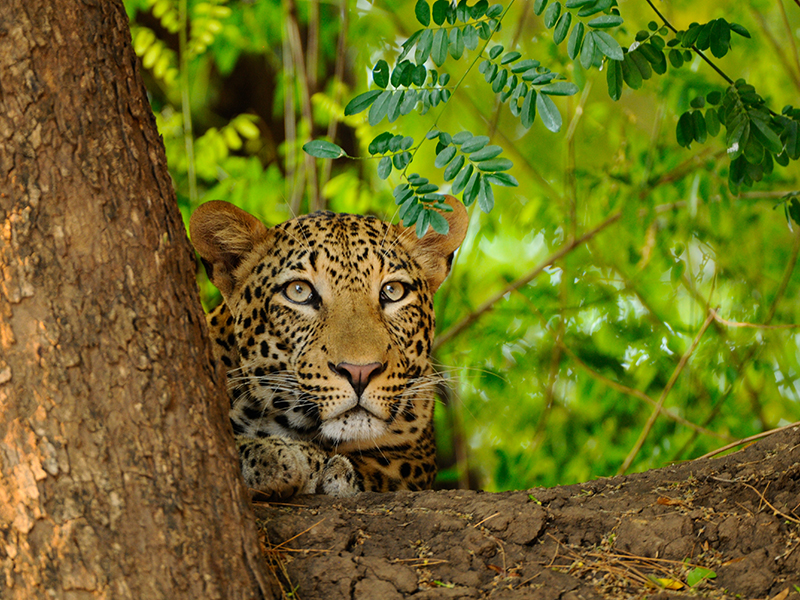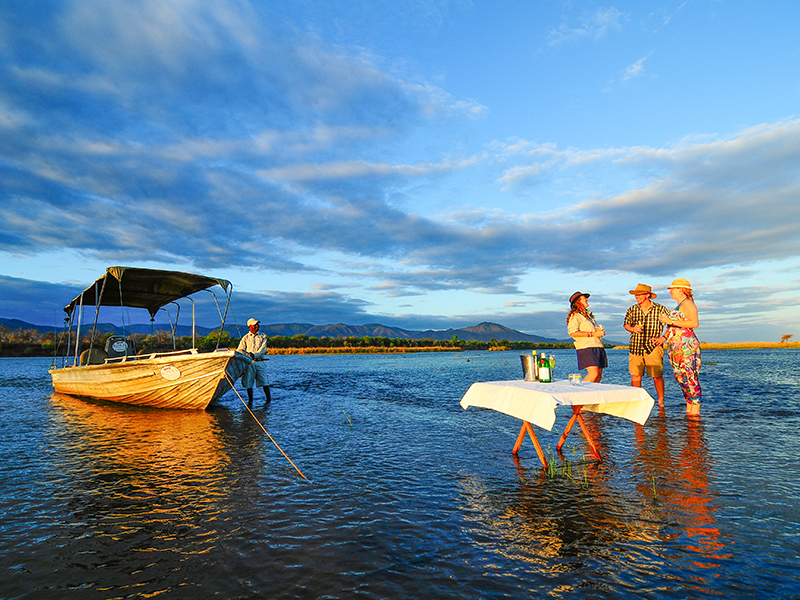About Zambia
Landlocked in central Southern Africa, Zambia is still viewed as one of the continent’s most wild and remote wilderness areas, although in recent years has grown much interest for intrepid and luxury travellers alike. It boasts front-row seats to Africa’s only Natural Wonder of the World – the Victoria Falls, and is also a large country with many hidden wonders. The scenery, extraordinary game viewing, unbeatable safari guides and top-notch accommodation ranging from eco-bush camps to luxury lodges, all make this country a must-do for those looking to experience a bit of “real” Africa.
Top Destinations in Zambia
- Livingstone: Historical town with access to the dazzling Victoria Falls
- Lower Zambezi National Park: Canoeing safaris, remote wilderness, fishing and excellent game viewing
- South Luangwa National Park: Walking safaris make this destination unique to any other in Zambia
- Kafue: A massive and remote park with the largest number of different antelope species of any park in Africa
- Liuwa Plain National Park: Largely unexplored park for that truly off-the-beaten-track safari, rare known wildebeest and zebra migration
Points of Interest
Livingstone:
In the country’s southwest corner, where the Mighty Zambezi River cascades over a crevasse 1,688m wide falling 100m before zig-zagging its way through the narrow Mupata Gorge, lies the historic city of Livingstone. Livingstone has built some stunning lodges along the river giving guests the opportunity to tick Victoria Falls off their bucket list and experience some of the continent’s most thrilling adrenaline activities like white water rafting, micro-lighting and bungee jumping. The town itself, which often doesn’t receive more than a passing glance, houses some delicious and diverse restaurants, a craft market for locally-made curious and souvenirs, and a Museum with extensive history on Dr. David Livingstone’s travels.
Lower Zambezi National Park:
Zambia gets its name from the Mighty Zambezi River running along the eastern region of the country, and forming the border between Zimbabwe in the south. Before this river reaches Mozambique on its way to the Indian Ocean, it becomes part of a remarkable area of Zambia known as the Lower Zambezi National Park. Along the banks of the river, tall and grandiose leadwood, ebony, and acacia forests become a sanctuary for wildlife during the dry season, and the wildlife then uses the Zambezi as their main source of nourishment when inland pans have evaporated. Safari drives through these ancient forests are an excellent way to view wildlife in impressive numbers with a stunning backdrop to beat, and Four of the Big Five animals can be spotted here. Canoeing and boating safaris are also an excellent way to experience the river and try your luck at catching the feisty Tiger Fish.
South Luangwa National Park:
The Luangwa River, which meanders gracefully and freely through Zambia’s eastern central region creates a land of unparalleled flora and fauna which make this massive park one of the most famous National Parks in southern Africa. In addition to world class game drives, this park also conducts walking safaris and night drives, giving guests an opportunity at seeing wildlife they wouldn’t normally spot in a vehicle during the day. Four of the Big Five are found in here in addition to over 450 species of birds, and the world’s largest concentration of crocodiles and hippos.
Kafue:
Although this park is one of the largest in Africa covering a staggering 22,400 square kilometers, Kafue still has very few tourists. This is a definitely a park for those who want to escape and get off the beaten track. It boasts 19 species of antelope, the largest variety of antelope of any park in Africa. The Busanga Plains are perhaps this park’s richest game area due to its marshy and expansive open terrain. When the water in this area recedes in the dry season, wildlife are attracted to this area’s lush vegetation. Hot air balloon rides offered over the Buganga Plains are an exceptional way to take in this vast landscape and spot wildlife from above.
Liuwa Plain National Park:
We mention “remote” and “off the beaten track” a few times when describing destinations in Southern Africa. However, if there is one park that exceeds all others with regards to exclusivity and remoteness, the Liuwa Plain National Park may just be the winner. With only a handful of accommodation options, most being mobile safaris or bush camps, it is not uncommon to explore this park and not see another vehicle. The road networks in the park were only established a few years back, and prior to that, the over 3,500km park was just untouched African wilderness. It is home to a substantial migration where tens of thousands of blue wildebeest, and thousands of tsessebe, zebra, and other plains gather at the beginning of the wet season. The best time to visit is the start of the rainy season: November-December.
Travel information
Getting there: Livingstone and the capital city Lusaka are both international airports and easy access points to the nearby parks. There are a number of large airlines who fly into Lusaka, and one local airline (ProFlight) who operate smaller aircraft to transport guests to more remote locations.
Visa Requirements:
- Entry permits can change so best to contact your local Zambian Embassy before traveling
- Passports must be valid for at least 6 months
- All visitors must carry their onward or return airline ticket
- Citizens from most countries can obtain a visa upon arrival or don’t require a visa at all
- If you have visited a country with yellow-fever, you must present a vaccination certificate at immigration
Currency:
- The Zambian Kwacha is the official currency of the country and typically shadows the South African Rand rates.
- Credit Cards are accepted at most lodges and restaurants, however it is always good to carry cash with you for tipping, and purchases in more remote areas.
Tipping:
As in most parts of the world, tipping is completely up to a guest’s discretion and whether or not he was satisfied with the service provided.
- Who?
- Your guides and staff at a safari lodge, and game scouts if you participated in walking safaris
- When?
- How much?
- Guides: roughly $5-10 per guest for half-day activities, double for full day excursions
- Lodge Staff: $3-8 per guest per day
- Scouts: $5-10 per guest per activity
Seasonal Information
Because Zambia is such a large country, it’s difficult to define a “best time to visit” as it all depends on where you are going and why you are traveling. For the majority of the parks, wildlife viewing is best done during the dry months. Viewing the Victoria Falls is best done just at the end of the rainy season (May-June) – but make sure you bring your poncho!
January – April: Wet Season (Summer)
Zambia can see some heavy thunderstorms and downpours over this period. Typically its not the best time to visit as it will be difficult to spot game due to the thick bush and availability of water for the wildlife. A majority of the parks in the main areas are shut due to the amount of water in floodplains and valleys.
May: End of Wet Season
Rains begin to dissipate and temperatures are starting to cool as winter approaches. This is typically when the flow of water cascading off the Falls is at its highest, but this also means the “spray” is immense – which may hinder your view of seeing the actual waterfall.
June-August: Dry Season (Winter)
Temperatures have dropped which can make for chilly morning game drives. But the bush has started to dry up so game viewing is much more rewarding than in other times of the year.
September-October: Dry Season (Coming out of winter)
For game viewing this is the best time, but can also be the hottest time of year to visit where in some areas the emperature can exceed 40 degrees.
November – December: Beginning of Wet Season (Summer)
November is always an ambiguous month with regards to climate. It could still be hot and dry, or the rains could have begun. December is guaranteed afternoon showers and high humidity, but it’s also a lovely time to watch the dry African bush spring back to life.
Zambia's Wildlife
It is very difficult to put the category of wildlife in Zambia into one box. Each different area boasts unique concentrations of game, all spectacular in their own way. Because of its low lying tropical wetlands in particular areas more rare antelope can be spotted. Its river systems are home to some of the worlds highest concentrations of crocs and hippos. Birdlife is also phenomenal in marsh areas, and predators thrive in the open plains where large herds of plains game graze.



